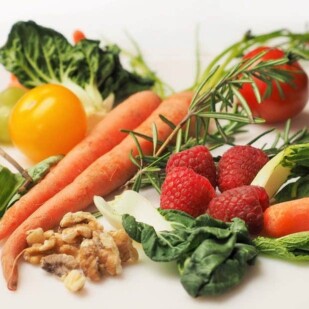Have you heard of the ‘gut-liver axis’? Truth be told, our liver and gut are highly connected and one system can impact the other. So if you have Irritable Bowel Syndrome (IBS) and have also been told you may have a fatty liver or diagnosed with Non-Alcoholic Fatty Liver Disease (NAFLD), then this might not be simply a coincidence!
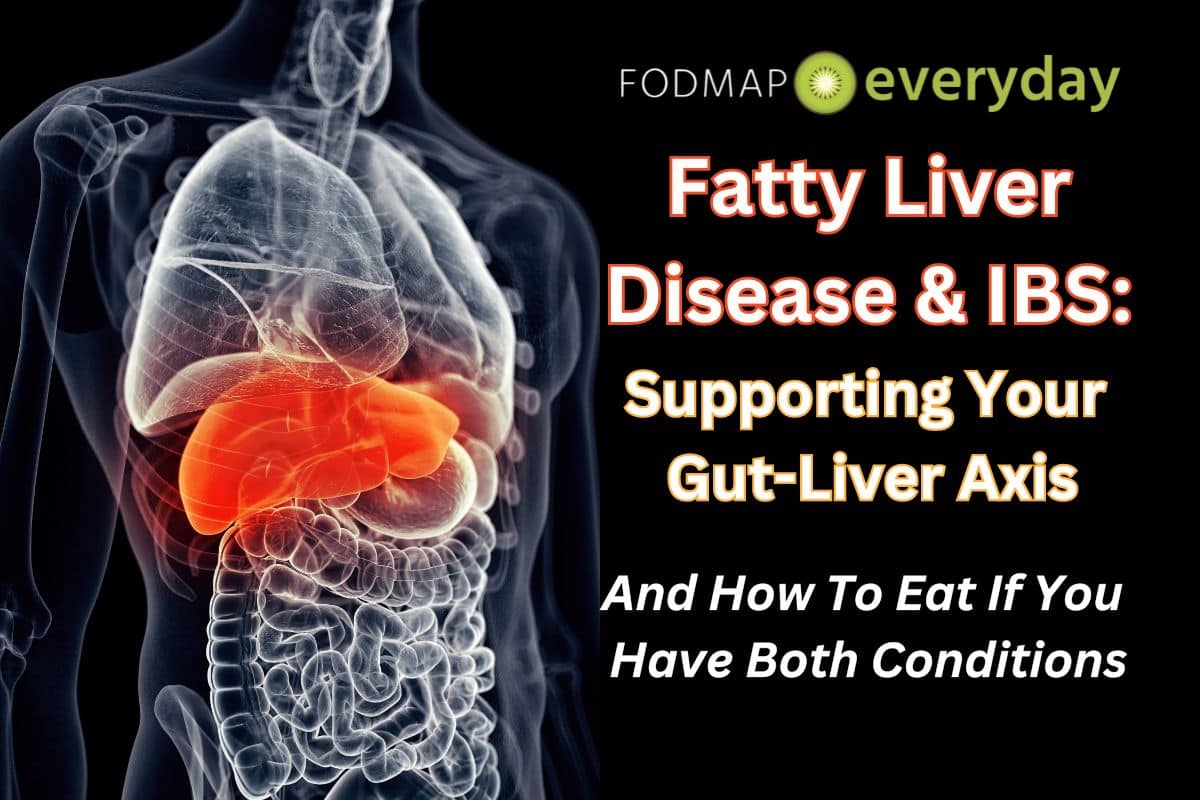
This said, you may have been diagnosed with both conditions, and so you feel a little overwhelmed at how to manage both of these conditions through diet changes. Well, good news – improving your gut health can also improve your liver health and vice versa! Not only is there an overlap of diet and lifestyle strategies, but supporting each system can help to improve the other.
For this article, we will dive deep into the connection between your gut and liver, and strategies to support liver health and IBS through nutrition and lifestyle shifts.
What is IBS?

IBS is a chronic, functional gut disorder characterized by abdominal pain or discomfort along with a range of other symptoms, including bloating, diarrhea, constipation, or alternating episodes of both. The exact cause is not known and we are learning more and more about the condition.
However, IBS has some common underlying drivers of symptoms including dysbiosis (aka imbalance in the gut microbiome), abnormal intestinal motility (aka movement in the small and large bowels), altered gut-brain connection, visceral hypersensitivity, and low grade inflammation in the gut. Many of these are also risk factors for fatty liver disease (more on that below).
Learn more about what IBS is, key symptoms and causes in our article What Is IBS?
What is Fatty Liver Disease?
Fatty liver disease is a general term, and there are two main forms of fatty liver disease: alcohol-induced fatty liver disease (AIFLD) and non-alcoholic fatty liver disease (NAFLD). AIFLD is caused by excessive alcohol use, while NAFLD can occur in those who are not considered to have excessive alcohol intake.
NAFLD occurs when there is fat in the liver, and is defined as 5% or greater fat content in the liver. NAFLD is more common, and affects 1 in 4 adults globally. It’s considered on the rise, and more and more we are seeing this condition in younger adults as well.
Non Alcoholic Fatty Liver Disease has two main types (1):
- Non Alcoholic Fatty Liver (NAFL): Also known as simple fatty liver, this is when you have fat in your liver but no inflammation or damage. It is not considered to progress to complications, but may cause some abdominal pain due to enlargement of the liver (which could be confused with symptoms of IBS if both are present!).
- Non-Alcoholic Steatohepatitis (NASH): This is a more serious form of NAFLD and occurs when you have both inflammation and liver damage, as well as fat in the liver. NASH can progress through various stages if left untreated including fibrosis (aka scarring of liver tissue). Permanent scarring can lead to cirrhosis of the liver, where regular healthy tissue is taken over by scar tissue and the function of the liver is severely impacted. Cirrhosis can lead to liver cancer.
NAFLD is considered a ‘silent disease’ as there are not many symptoms present. However, in the later stages of NASH, specifically fibrosis and cirrhosis, symptoms may present such as fluid accumulation in the abdomen, dull abdominal pain, extreme fatigue, skin changes and unexplained weight loss.
How Do You Know If Your Liver Is Functioning Well?

How do you know if your liver is functioning well? Often, clear symptoms do not show up until liver disease has progressed, such as weight loss, jaundice (aka yellow skin), stool color changes and extreme fatigue.
However, some signs that your liver may not be functioning at it’s best include:
- High cholesterol and/or triglyceride levels (as the liver works to regulate these components in our blood and body)
- Fatty liver shown in ultrasound
- Elevated liver enzymes (ALT, ALP, AST, GGT) or Bilirubin
- Skin issues, poor immunity, digestive issues
- Recurrent Small Intestinal Bacterial Overgrowth (SIBO) due to build up of pathogenic bacteria not being able to be properly treated as a result of some issues with the gut liver axis (more on that below)
If you or your doctor are concerned about liver function, you may look at the following blood work tests (2).
- Liver enzyme test: ALT, ALP, GGT, AST
- Liver protein test: Albumin, Globulin, Prothrombin
- Bilirubin test: Bilirubin in urine or blood
- Lipoprotein panel: Cholesterol (HDL, LDL, Total Cholesterol)
- and triglycerides
Of course, we recommend to speak to your doctor for proper testing if you are concerned about liver health and especially if you have any of these more concerning symptoms:

- Jaundice (yellow skin and eyes)
- Fatigue
- Weakness
- Loss of appetite
- Accumulation of fluid within the abdomen
- Clay/pale stool colour
- Tendency to bruise easily
Functions of the Liver
Did you know that the liver is one of the largest organs in the body? It is located in the upper right part of the belly (beneath the diaphragm and above the stomach, right kidney and intestines). The liver is considered the body’s ‘master detoxifier’ – it plays 100s of roles in our body and its main purpose is to remove wastes and prevent toxins from building up in our body and blood. It is literally a superhero!
Some key functions of the liver include (3):
- Storing glycogen for energy (aka long term carbohydrate storage for extended periods of exercise or fasting)
- Metabolism of carbohydrates, protein, and fat
- Micronutrient conversion and/or storage of vitamin A, vitamin D, water soluble vitamins, iron, and zinc
- Detoxification of drugs, alcohol, and toxic substances
The Gut-Liver Axis
You’ve heard of the gut-brain axis, but how about the ‘Gut-Liver Axis? This is essentially the bi-directional relationship between the gut-microbiome and the liver. These two complex systems interact and influence each other, mainly through the portal vein. Approximately 70% of the blood flowing from the portal vein into the liver comes from the intestinal tract (4). Due to shared blood flow, each system closely affects each other and so damage to one system can result in damage to the other.
The liver secretes bile acids and IgA antibodies into the intestinal tract. Bile acids are substances made by the liver which are then absorbed into the small intestine to help with breakdown of fat and fat-soluble vitamins, as well as excretion of cholesterol from the body.
The immunoglobulin A (IgA) antibodies secreted into the intestinal tract by the liver are responsible for immunity by protecting the mucous membranes. Thus, a reduction in bile acid secretion from the liver can lead to inflammation and microbial overgrowth in the gut (5) Pretty fascinating, huh?
On the other hand, the liver receives nutrients, toxins, antigens, and small amounts of gut microbial components through the blood in the portal vein. The liver then works hard to remove foreign invaders such as pathogens or other potentially dangerous microbial components from the intestinal tract. Did you know that the liver is the first organ to be exposed to gut derived products? So it plays a very crucial role and gets exposed to a lot!
Getting back to fatty liver disease – pathogens that are sent to the liver from the gut can further cause liver damage by putting more stress on the liver, especially if the liver is already compromised. This can lead to intestinal dysbiosis or SIBO if the liver is not able to properly clean out this blood (4).
NAFLD and IBS are two of the most common GI disorders, and often occur together.
When there is dysbiosis of the gut microbiomes (aka less’ good’ microbes and more ‘bad’ microbes in the gut), this can cause a steady, low level of chronic inflammation which then can be passed onto the liver and result in the development of NAFLD. Some of these microbes are gram negative bacteria and can cause significant damage due to the presence of Lipopolysaccharides (LPS), an endotoxin, present in the outer membrane of their cell walls (3). LPS can cause inflammation and damage to the intestinal barrier. As the LPS travels to the liver through the portal vein, it can cause inflammation within the liver and ultimately contribute to the development of steatosis and fibrosis of the liver (3).
In short, as these two systems work symbiotically, changes in the composition of the gut microbiome and pathogenic bacterial overgrowth, can lead to a greater amount of pathogenic microbes and their components reaching the liver resulting in damage to the liver and inflammation over time. Studies have shown that individuals with NAFLD tend to have lower gut microbiome health and diversity (6).
IBS & Fatty Liver Disease
NAFLD and IBS are two of the most common GI disorders, and often occur together.
Common risk factors for both conditions include chronic inflammation, dysbiosis (aka imbalance in the gut microbiome), Small Intestinal Bacterial Overgrowth (SIBO), diet, high stress, and poor sleep (3).
Due to these risk factors and the gut-liver axis as we just explained, IBS and fatty liver may present together.
There may also be some connection between IBS-D (Diarrhea Dominant IBS) and liver damage due to issues with bile production and their metabolism. As mentioned, bile is a solution produced by liver cells that helps us to digest fats, absorb fat soluble nutrients (Vit A, Vit D, K) and remove excess cholesterol. Bile production is essential for good digestion. If bile ducts become damaged due to gut microbiome dysbiosis, this can impact the breakdown of stool and potentially cause or worsen symptoms in IBS (7).
Diet and Lifestyle Tips to Support Liver Health When You Have IBS
So now that we’ve got a clear understanding of these two conditions, and the risk factors, let’s discuss ways to manage them through your diet. Key goals when you have IBS and fatty liver are to lower inflammation, correct nutrient deficiencies, and help feed good gut bacteria (especially Bifidobacterium) to foster a healthy microbiome.
Essentially, we want to support an anti-inflammatory diet that helps to foster a diverse and healthy gut microbiome.
Mediterranean Diet
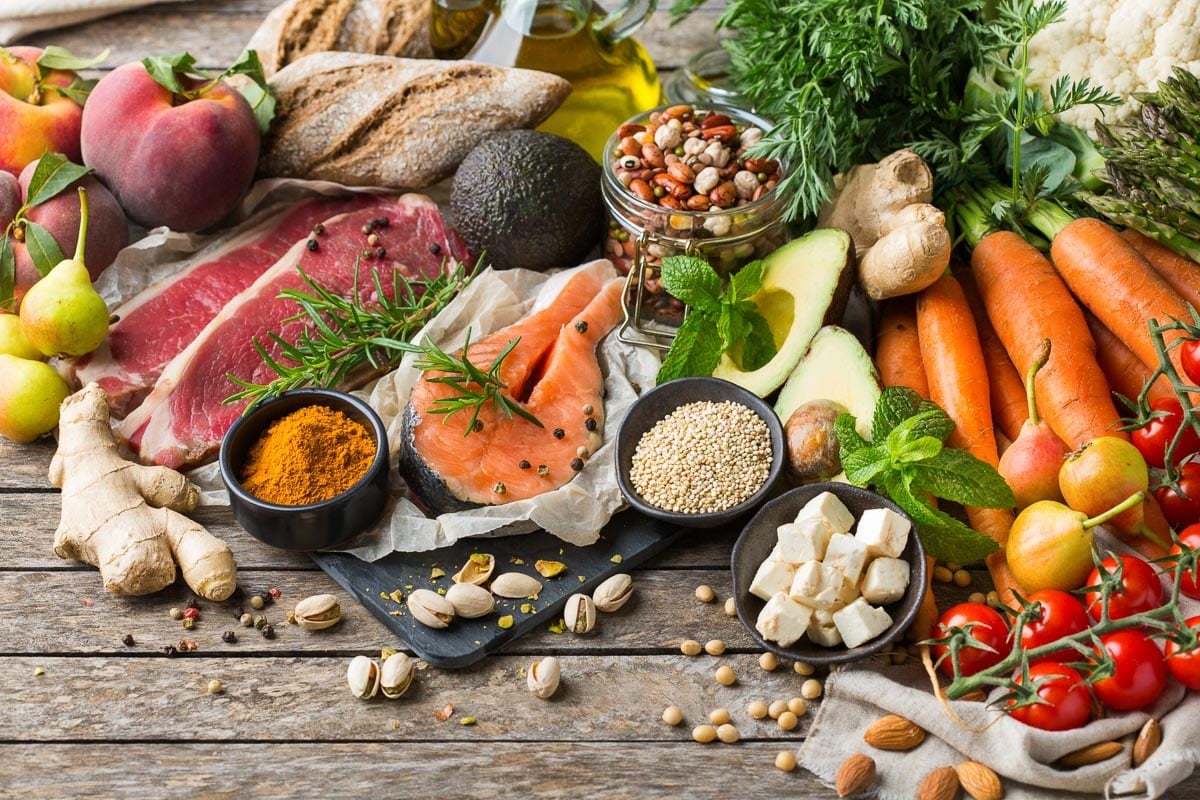
The Mediterranean Diet is an eating pattern based on populations of people in mediterranean countries with long life spans.
This diet pattern emphasizes plant-based foods, local foods and cooking from scratch:
- Healthy fats & cooking oils: extra-virgin olive oil, nuts, seeds, and fatty fish (omega-3)
- Plant foods & fiber: vegetables, fruits, whole grains
- Lean proteins: poultry, beans/lentils
- Focus on fresh & local, avoiding ultra-processed foods
- Making homemade meals with family
It also recommends low-to-moderate levels of red wine consumption, milk, meat, and dairy products.
Research has shown that the Mediterranean Diet can be helpful specifically in NAFLD. Specifically, a review of the literature showed that those who followed a mediterranean diet decreased liver fat accumulation, triglycerides, cholesterol, and inflammatory biomarkers (8). The reason it is effective is likely because it encourages consumption of probiotics, prebiotics, fiber-rich foods, polyphenols, and antioxidants (8).
While a low FODMAP diet helps with symptoms in IBS, principles of the Mediterranean Diet when combined with a low FODMAP diet may help to reduce the associated inflammatory response (9). Speak with your Registered Dietitian for help incorporating principles of a Mediterranean diet into your low FODMAP eating pattern.
Consume Enough Omega-3 (EPA & DHA) Fats

These fats are essential for regulating inflammation in the body. Most get enough omega-6 (pro-inflammatory) and not enough omega-3 fats (anti-inflammatory).
Recommendation:
- Approx. 1500mg per day of EPA & DHA fats
- In practice, this looks like consuming: 3 oz (1 palm) of fatty fish 2-3 times per week (salmon, trout, sardines, mackerel).
If you’re allergic, dislike fish and/or are vegan/vegetarian, consider taking a high quality supplement (in triglyceride form) under the guidance of a healthcare professional.
Eat Low FODMAP Fiber
Did you know, most North Americans are getting only 50% recommended amount of fiber?
Short chain fatty acids (SCFAs) are produced when the friendly bacteria in your gut ferment fiber in your colon. SCFAs help metabolize nutrients like carbs and fat, lower gut lining inflammation, and reduce the risk of liver disease, colon cancer, heart disease, obesity, and type II diabetes.
Getting enough fiber is essential for lower gut and liver inflammation, as well as a healthy, diverse gut microbiome which as we know supports our gut-liver axis. However, some high fiber foods are also high FODMAP so we have to choose mindfully.
Aim to get at least 25-30 grams of fiber per day for women, and 35-40 grams of fiber per day for men.
Low FODMAP fiber sources include:
- Raspberries (58g)
- Edamame (90g)
- Chia seeds (24g)
- Flax (15g)
- Popcorn (120g)
- Kiwi (150g)
- Kabocha squash (75g)
- Quinoa (155g)
- Potatoes (75g)
For more information on how to get enough fiber while following the low FODMAP diet read: Fiber and Irritable Bowel Syndrome: What You Need To Know.
Consume Prebiotic Foods With Inulin
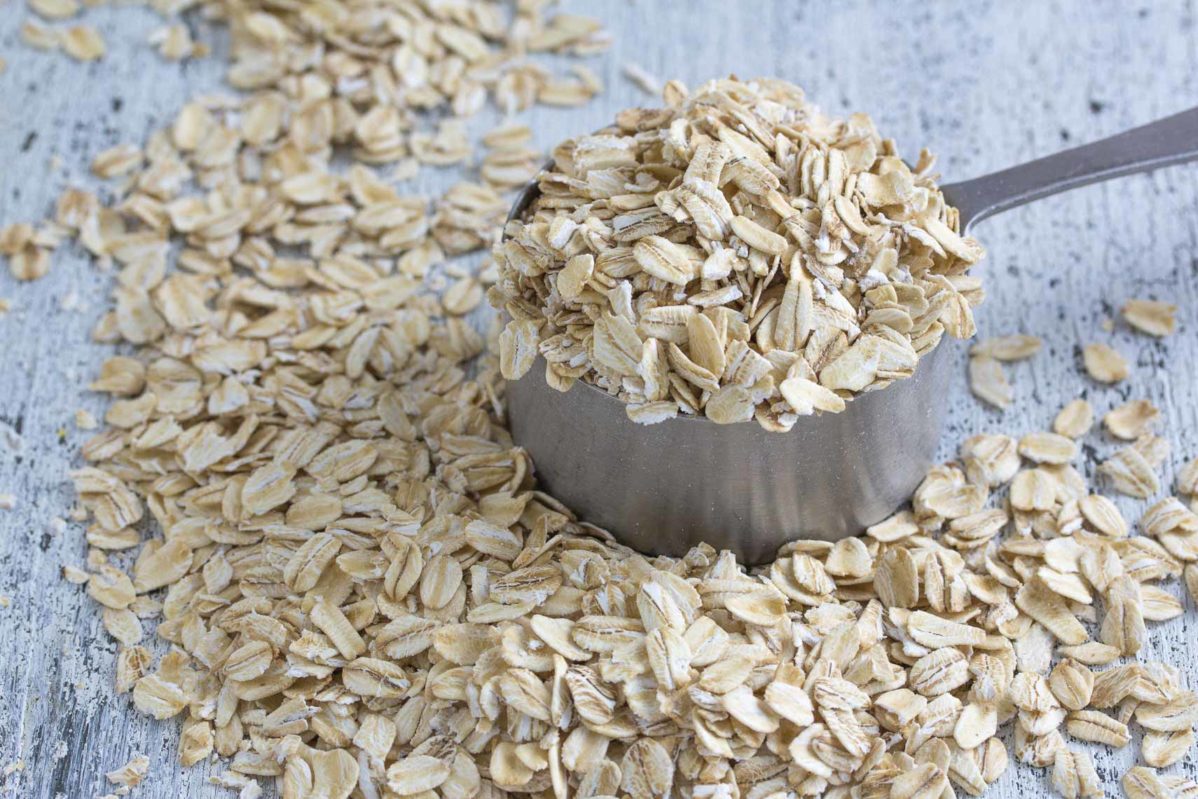
Prebiotics’ are the fuel source for your good gut bacteria, and inulin specifically helps to feed ‘Bifidobacterium’ – a type of good bacteria that reduces inflammation in our gut lining and supports immunity.
Consume at least 1-2 food sources each day. Although inulin is high FODMAP, it is found in smaller amounts in some low FODMAP foods. Low FODMAP sources of prebiotics and inulin include:
- Walnuts (8-10; 30 g is a low FODMAP portion)
- Sunflower seeds (¼ cup would offer a good amount; note that 6 g, or 2 teaspoons, is considered a low FODMAP portion per Monash University testing)
- Rolled oats, uncooked (52g)
- Jicama (75g)
- Green banana flour (100g)
- Firm tofu (170g)
- Pumpkin seeds (23g)
- Non-spotted bananas (100g)
- Pickled onions (45g)
- Asparagus (12g)
Healthy Fats
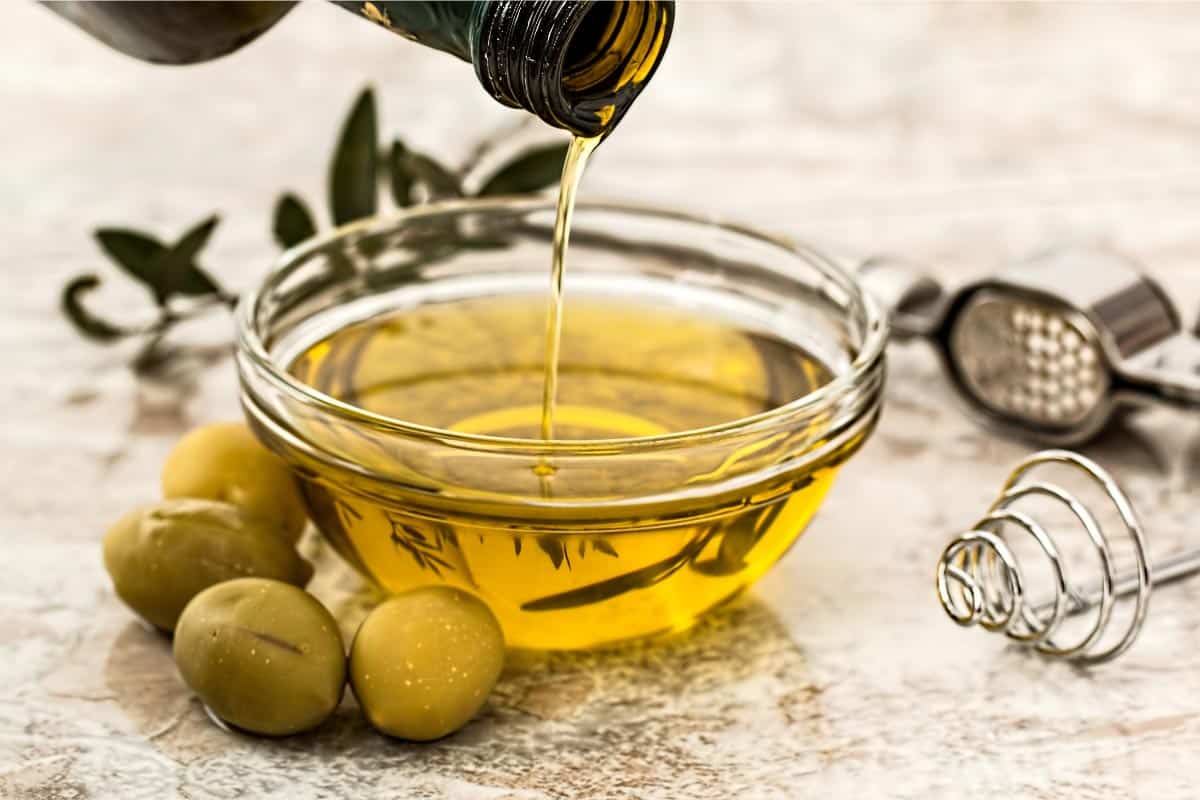
We want to focus on healthy fats from mono and polyunsaturated sources in our diet which help to regulate inflammation, and a lower amount from saturated sources (meats, dairy). Focus on cold-pressed and minimally processed fats from nuts, seeds, eggs and fatty fish daily.
Some examples of low FODMAP healthy fats include. Use the Monash University and FODMAP Friendly apps for specific amounts of some of the following. For pure fats like oils, and pure proteins like fish, they contain no FODMAPs and portions can be generous::
- Cooking: extra virgin avocado or olive oil
- Dressing: extra virgin olive oil, cold-pressed flax oil
- Raw nuts and seeds (such as chia, pecan, macadamia, sunflower, pumpkin)
- Nut and seed butters
- Pastured eggs
- Butter (grass fed)
- Fatty fish (salmon, trout, sardines, mackerel)
Eat Fermented Foods Daily
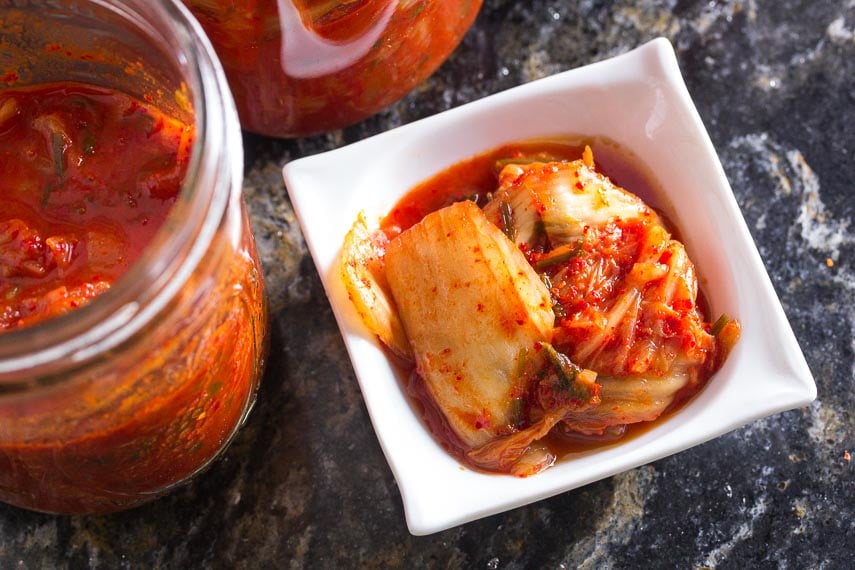
Fermented foods like kefir, sauerkraut and sourdough bread have been shown to improve gut microbiome diversity when consumed regularly. They also have been shown to lower markers of inflammation, which is extra important for liver health!
For clarity, ‘fermented food’ refers to foods that have been fermented for preservation and/or flavoring purposes, not to be confused with FODMAPs which are long chains of sugars and sugar alcohols that are fermented by gut bacteria in our large intestine.
Low FODMAP fermented foods include:
- Kefir (lactose-free)
- Sauerkraut (20g)
- Kimchi (47g)
- Tempeh (100g)
- Miso paste (12g)
- Sourdough bread, wheat or oat (50g)
- Pickles
Learn more about fermented foods in our collection of articles on FODMAPs and Fermentation.
Try Coffee (if you can tolerate it)
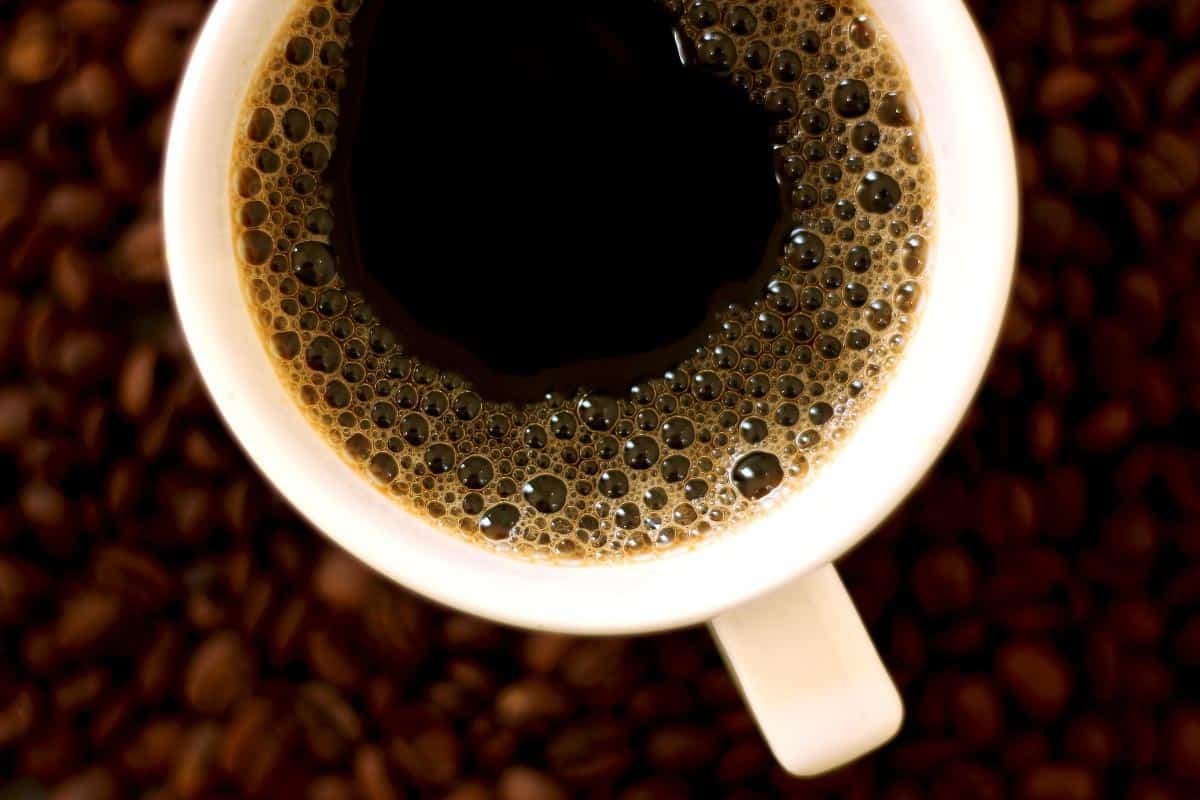
Drinking coffee has been shown to help prevent buildup of fat and collagen in the liver, while decreasing inflammation by increasing glutathione levels, an antioxidant found in coffee (10).
Further, coffee has been shown to lower the risk of death in people with chronic liver disease and risk of fibrosis and cirrhosis (two common liver diseases) (10).
However, we know that coffee can be an irritant in IBS, by triggering abdominal pain, heightened anxiety and loose stools due to the caffeine content and ergogenic acid. This said, each person’s tolerance is unique, and some people can stick to moderate amounts of coffee. As well, what you add to your coffee affects its nutrition content and impact on your gut as well.
Here are our IBS-friendly tips for consuming coffee:
- Have black, or with unsweetened almond (1 cup), oat milk (½ cup), or lactose-free milk. Skip the added sugar.
- Limit to 2 or less 250ml cups per day of regular coffee to prevent an excess of caffeine consumption (which is more likely to trigger anxiety and loose bowels).
- Avoid drinking regular coffee at least 8 hours before sleep to avoid impacting your sleep hygiene.
If even a small amount of coffee does not go well for you, then skip this tip and try out the tea suggestions below!
Teas for Liver Health
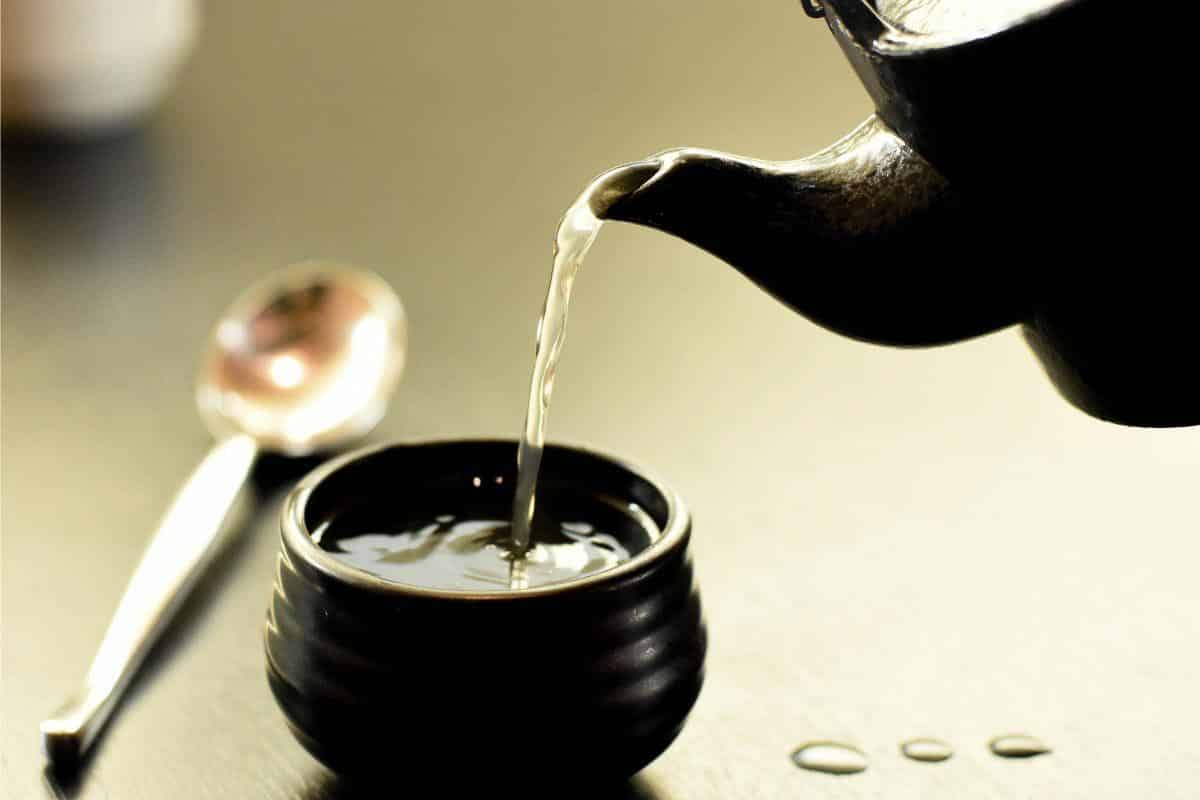
Dandelion root tea:
Dandelion tea may help to stimulate bile production, which is important for fat digestion and liver health. Try 1 cup (240 ml) of lightly steeped dandelion tea daily for a low FODMAP option.
Green tea:
Green tea is high in antioxidants that lower inflammation, and is low FODMAP. Try including 1-2 cups (240 ml to 480 ml) daily. However, as it does contain caffeine (about ⅓ the amount of coffee), use it to replace with your coffee, or keep to max 1 x 240 ml cup of each.
Support Your Body’s Natural Detoxification Pathways

Sleep hygiene:
Quality sleep is key for liver health as it is our body’s time to repair and recover! Opt for 8-9 hours per night of good quality sleep.
See our article How Does Sleep Impact IBS for more information.
Sweat regularly:
Sweating is one of the ways your body gets rid of toxins, and supporting this system may help with liver health. Aim to sweat at least 4-5 times per week. Do whatever activity feels good and is within your capabilities: walk, run, yoga, take a bath, bike, or use a sauna.
Consider Your Body & Cleaning Products
What you put ON your body and in your environment matters too! Our bodies absorb contaminants from the air we breathe and products we use. If it’s within your budget, consider natural beauty & cleaning products: make up, lotions, shampoos, laundry detergent, room spray, and floor cleaner. Many of these commercial products contain endocrine disrupting chemicals and some have debatable carcinogenic effects.
How to shop for cleaner products:
- Aim to avoid products with: parabens, sulfates or SLS (Sodium Laureth Sulfate), lead, mercury, and FD&C coloring (synthetic dyes)
- Look for the Environment Working Group (EWG) symbol, or check specific products on their website.
You can also try out easy and safe natural swaps for cleaning:
- White vinegar: mix with water and use for floor, window and surface cleaning
- Baking soda: use it to soak and scrub dirty pots & pans; for extra support with dirty laundry
- Essential oils: add them to water in a spray bottle and use it as a natural air freshener
- Coconut oil: use as body lotion
Liver Cleanses & Detoxes
We can’t talk about liver health without some mention of liver cleanses and detoxes. Have you been told to take one? Well, here is the low down. If you take care of your liver on a regular basis, there is no need for a cleanse or detox. Your liver is a very robust organ, and it generally does a very good job at being your body’s master detoxifier.
This said, some people with more advanced liver disease might benefit from specific supplementation to help support liver health along with considerate diet and lifestyle changes. This would be directed by your medical team.
Instead of opting for a liver cleanse or detox to “undo” any poor habits, focus on maintaining a balance of the above strategies and aim for the 90/10 rule of nutrition and lifestyle support, and flexibility with your nutrition and lifestyle.
If you take care of your liver on a regular basis, there is no need for a cleanse or detox.
Work With a Registered Dietitian
All said, managing two chronic diseases at the same time can be overwhelming and as you can see there are quite a few strategies to focus on. If you need help with setting goals, meal planning, managing symptoms and improving your gut-liver axis, consider working with a specialized Registered Dietitian. Registered Dietitians are regulated health professionals and are the experts in nutrition care and medical nutrition therapy!
See our Global Dietitian Directory here to find the right fit for you.
The Takeaway

The gut-liver axis is an underappreciated, but highly important system in your body and something you do not want to ignore if you have fatty liver disease and/or IBS. The primary goals to focus on when you have IBS and fatty liver are to lower inflammation, correct nutrient deficiencies, and help feed good gut bacteria (especially Bifidobacterium) to foster a healthy, diverse gut microbiome. Supportive lifestyle practices like sleeping, sweating regularly, and being mindful of products we use can further support this connection.
Any questions about liver disease and the gut-liver axis? Let us know below!
Key points:
- The gut and liver are closely connected, and damage to one can affect the other.
- Focus on an anti-inflammatory diet for liver health: mediterranean, healthy fats, fiber, prebiotics and <10% inflammatory foods, coffee & green tea.
- Lifestyle is important too: sleep, lower stress, sweat, cold exposure & environment/body products.
- Focus on being consistent with supportive food & lifestyle habits, rather than cleanses/fancy supplements.
- Work with a specialized Dietitian if you need help with goal setting, meal planning, managing symptoms and supporting your gut-liver axis.
References
- Definition & Facts of NAFLD & NASH. (2021, April). National Institute of Diabetes and Digestive and Kidney Diseases. https://www.niddk.nih.gov/health-information/liver-disease/nafld-nash/definition-facts
- Hoffman, M. (2022). Liver Function Test. WebMD. https://www.webmd.com/hepatitis/liver-function-test-lft
- Purssell, H., Whorwell, P. J., Athwal, V. S., & Vasant, D. H. (2021). Non-alcoholic fatty liver disease in irritable bowel syndrome: More than a coincidence?. World journal of hepatology, 13(12), 1816–1827. https://doi.org/10.4254/wjh.v13.i12.1816
- Jasirwan, C. O. M., Lesmana, C. R. A., Hasan, I., Sulaiman, A. S., & Gani, R. A. (2019). The role of gut microbiota in non-alcoholic fatty liver disease: pathways of mechanisms. Bioscience of microbiota, food and health, 38(3), 81–88. https://doi.org/10.12938/bmfh.18-032
- Hersoug, L. G., Møller, P., & Loft, S. (2016). Gut microbiota-derived lipopolysaccharide uptake and trafficking to adipose tissue: implications for inflammation and obesity. Obesity reviews : an official journal of the International Association for the Study of Obesity, 17(4), 297–312. https://doi.org/10.1111/obr.12370
- Rau, M., Rehman, A., Dittrich, M., Groen, A. K., Hermanns, H. M., Seyfried, F., Beyersdorf, N., Dandekar, T., Rosenstiel, P., & Geier, A. (2018). Fecal SCFAs and SCFA-producing bacteria in gut microbiome of human NAFLD as a putative link to systemic T-cell activation and advanced disease. United European gastroenterology journal, 6(10), 1496–1507. https://doi.org/10.1177/2050640618804444
- Min, Y. W., Rezaie, A., & Pimentel, M. (2022). Bile Acid and Gut Microbiota in Irritable Bowel Syndrome. Journal of neurogastroenterology and motility, 28(4), 549–561. https://doi.org/10.5056/jnm22129
- Suárez, M., Boqué, N., Del Bas, J. M., Mayneris-Perxachs, J., Arola, L., & Caimari, A. (2017). Mediterranean Diet and Multi-Ingredient-Based Interventions for the Management of Non-Alcoholic Fatty Liver Disease. Nutrients, 9(10), 1052. https://doi.org/10.3390/nu9101052
- Kasti, A., Petsis, K., Lambrinou, S., Katsas, K., Nikolaki, M., Papanikolaou, I. S., Hatziagelaki, E., & Triantafyllou, K. (2022). A Combination of Mediterranean and Low-FODMAP Diets for Managing IBS Symptoms? Ask Your Gut!. Microorganisms, 10(4), 751. https://doi.org/10.3390/microorganisms10040751
- Wadhawan, M., & Anand, A. C. (2016). Coffee and Liver Disease. Journal of clinical and experimental hepatology, 6(1), 40–46. https://doi.org/10.1016/j.jceh.2016.02.003

